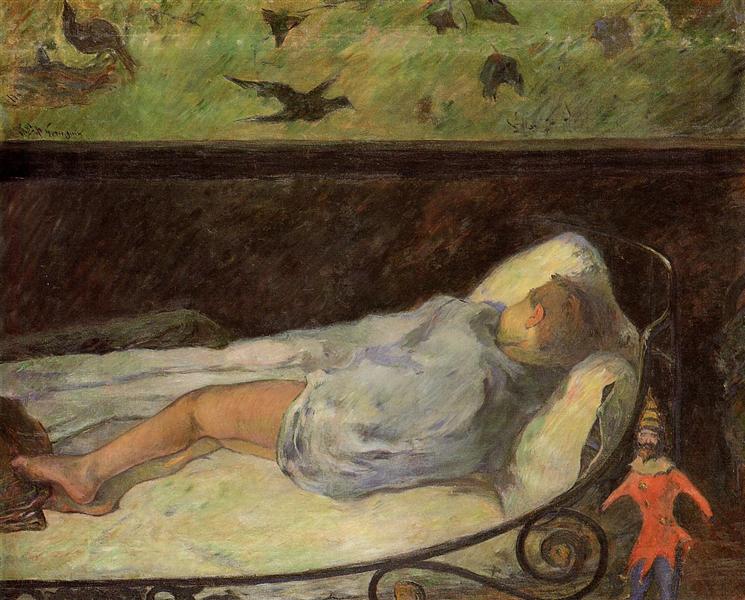Description
Paul Gauguin's painting "Dreaming Girl (Study of a Sleeping Child)", created in 1881, represents an intimate and evocative exploration of the world of children through a technique that was already beginning to distance itself from the academic conventions of the time. This work is situated at a crucial moment in Gauguin's career, who, after his experience in the studio of artists such as Camille Pissarro and Edgar Degas, was beginning to develop his own voice, influenced both by Impressionism and by the search for a more symbolic and emotional representation.
Compositionally, the painting captures a young sleeping girl lying carefree against a neutral background, emphasizing the vulnerability and peace of the moment. The girl's figure is positioned centrally, drawing the viewer's attention to her serene expression. Her face, slightly turned, suggests a dreamlike state, an interval between reality and the dream world. The use of soft lines and sharp contours around the girl's figure provides a sense of warmth that is accentuated by the treatment of light.
The use of colour is remarkable. Gauguin opts for a palette that combines warm and soft tones, in which pinks, yellows and browns predominate, achieving an enveloping atmosphere that invites contemplation. Contrary to the Impressionists' tendency towards greater luminosity, here there is an element of planning and colour harmony that recalls Nordic and Symbolist art, with nuances that suggest both tenderness and emotional depth. Each tone seems to be selected not only for its capacity for naturalism, but also for its potential to evoke sensations.
The absence of other characters in the painting highlights the singular focus on the child, facilitating an in-depth study of her essence. This portrait in a state of repose could be interpreted as a representation of the innocence and introspection characteristic of childhood. The context of the painting suggests that Gauguin was interested in capturing the purity of childhood moments, as well as the complexities of dreams and imagination, themes that recur in various works of the period.
It is interesting to note that "Dreaming Girl" is contemporary with his most famous work, "La Orana Maria", and can be considered a preliminary exercise in his aesthetic experimentation before the search for more exotic and symbolic forms that would define his later work, particularly during his period in Tahiti. The influences of post-impressionism begin to become evident, and Gauguin's stylistic qualities begin to take shape from these types of intimate studies.
In conclusion, “Dreaming Girl” stands not only as a study of a sleeping child, but also as a powerful reflection on life, sleep and innocence. The work encapsulates a transformative period in Gauguin’s career where the search for the essential and the emotional was beginning to flourish. In this sense, the painting is both a tribute to childhood and a step towards building a personal style that would challenge the established norms of the art of his time.
KUADROS ©, a famous painting on your wall.
Hand-made oil painting reproductions, with the quality of professional artists and the distinctive seal of KUADROS ©.
Painting reproduction service with satisfaction guarantee. If you are not completely satisfied with the replica of your painting, we will refund 100% of your money.

